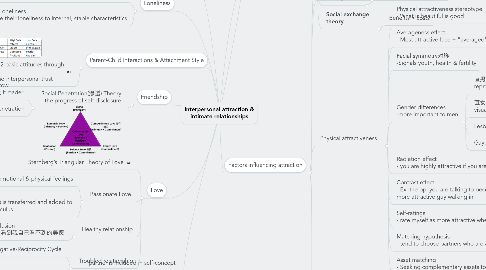
1. Intimacy
1.1. partner is included in self-concept
1.2. Partner-enhancing bias
1.3. Communal vs Exchange Relationships -Communal : 付出不求回报 - Exchange: 交换好处
2. Parent-Child Interactions & Attachment Style
2.1. Infants acquire 2 basic attitudes through interactions: -Self esteem and interpersonal trust
3. Friendship
3.1. Social Penetration(渗透) Theory - the progress of self-disclosure
3.1.1. Early in a relationship – shallow, narrow As relationship progresses – deeper, broader
3.1.2. Troubled friendships – depenetration
4. Love
4.1. Sternberg’s Triangular Theory of Love
4.2. Passionate Love
4.2.1. emotional & physical feelings
4.2.2. Excitation transfer theory -arousal caused by one stimulus is transferred and added to arousal elicited by a second stimulus
4.3. Healthy relationship
4.3.1. Positive illusion -在我身上看到我自己看不到的美德
4.4. Troubled relationship
4.4.1. Negative-Reciprocity Cycle
4.4.2. Jealousy - Sexual infidelity & Emotional infidelity
5. Loneliness
5.1. Adolescents, young adults ,older adults & Individualists more likely experience loneliness
5.2. Chronic Loneliness - attribute their loneliness to internal, stable characteristics
6. Social Anxiety
6.1. Two-factor theory of emotions -Emotion is caused by physiological arousal & cognitive labeling
6.2. Chronic social anxiety -Expect, readily perceive, & intensely react to rejection cues
7. Interpersonal Attraction Online
7.1. Hyperpersonal communication theory - Anonymity increases self-disclosure & interpersonal attraction
8. Need for Affiliation
8.1. Evolution
8.1.1. social pain= physical pain
8.1.2. Survival & Reproduction
8.2. Gender
8.2.1. Girls socialized to get emotional connectedness
8.3. Personality & the Brain
8.3.1. Extrovert vs Introvert
8.4. Culture
8.4.1. Individualists have higher affiliation needs
8.5. Social comparison theory
8.5.1. Needs others provide reference point to evaluate self
8.6. Social exchange theory
8.6.1. Benefits > costs
9. Factors influencing attraction
9.1. Proximity
9.1.1. Physical closeness between individuals
9.2. Familiarity
9.2.1. Mere exposure effect
9.3. Similarity
9.3.1. Tend to seek out others who are similar
9.3.2. Balance theory-sharing similar attitudes are likely to reach balance
9.4. Complementarity
9.4.1. add to what is missing in
9.5. Physical attractiveness
9.5.1. Physical attractiveness stereotype - What is beautiful is good
9.5.2. Averageness effect - Most attractive face = “averaged”, prototypical face
9.5.3. Facial symmetry对称 -Signals youth, health & fertility
9.5.4. Gender differences -more important to men
9.5.4.1. 直男:prefer characteristics that signal reproductive fitness
9.5.4.2. 直女: Power & function more important than visual appearance
9.5.4.3. Lesbian: Physical appearance less important
9.5.4.4. Gay: higher standards of body attractiveness
9.5.5. Radiation effect - you are highly attractive if you are paired with someone highly attractive
9.5.6. Contrast effect - Ex: the ppl you are talking to become less attractive when you see another more attractive guy walking in
9.5.7. Self-ratings - rate myself as more attractive when facing the same sex
9.5.8. Matching hypothesis - tend to choose partners who are a similar to us in physical attractiveness
9.5.9. Asset matching - Seeking complementary assets to exchange what they want from relationships
9.6. Self-disclosure
9.6.1. Willingness to share information about oneself
9.6.2. Too much self-disclosure can decrease attraction (Opportunity to find dissimilarity increase)
9.7. Reciprocal liking
9.7.1. We tend to like people who like us
9.8. Playing hard to get
9.8.1. Psychological reactance - Deprivation of the option makes us want it more
9.8.2. Sexual economics model - creating perception of limited supply (scarcity) & high demand
9.9. Reward Theory of Attraction
9.9.1. we like those who reward us and those we associate with reward)
9.9.2. Positive features evoke positive emotions
